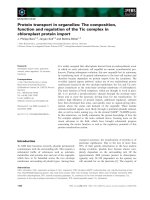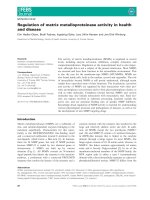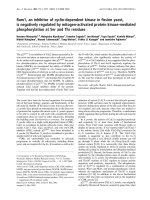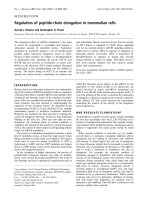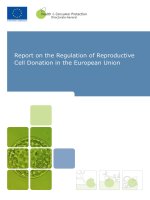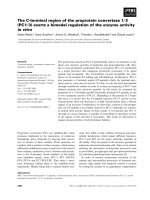Regulation of mitotic spindle biogenesis in budding yeast
Bạn đang xem bản rút gọn của tài liệu. Xem và tải ngay bản đầy đủ của tài liệu tại đây (656.88 KB, 176 trang )
REGULATION OF MITOTIC SPINDLE BIOGENESIS
IN BUDDING YEAST
CRASTA KAREN CARMELINA
(B. Sc. (Hons.), NUS)
A THESIS SUBMITTED FOR THE
DEGREE OF DOCTOR OF PHILOSOPHY
INSTITUTE OF MOLECULAR AND CELL BIOLOGY
NATIONAL UNIVERSITY OF SINGAPORE
2007
Acknowledgements
i
ACKNOWLEDGEMENTS
I would like to express my sincere gratitude and appreciation to A/P Uttam Surana, to whom I
am much indebted for his guidance, insightful and influential conversations, valuable advice and
the freedom to explore my curiosities. My sincere thanks also go out to members of my PhD
Supervisory Committee, A/P Mohan Balasubramanian and A/P Yang Xiaohang, for their
constructive comments and encouragement.
Special Thanks to my extended family, my labmates – Hong Hwa, Chee Seng, Wei Chun,
Jonathon, Joan, Zhang Tao, Saurabh, Jenn Hui, San Ling, Wee Kheng and Vaidehi for
sharing in the thrill along the path to discovery, help in various ways and for making lab life fun!
A big Thank You to all in CMJ lab for being such wonderful neighbours! I am also grateful to
Suniti Naqvi, Mithilesh Mishra and all in Mohan’s lab at TLL for their time in teaching me
fission yeast techniques. I wish to thank Prof. Mark Winey for providing technical expertise in
electron microscopy for various projects. Thanks also to the EM Unit, NUS for my training and
Chee Peng for help despite his busy schedule.
I am grateful to Drs Mark Winey, David Morgan, Wolfgang Zachariae, John Kilmartin,
Matthias Peter, David Pellman, Chris Hardy, Kyung Lee, Jiri Lukas and Michel Bouvier for
providing me with valuable reagents and Dr Mark Hall for helpful advice.
Special Thanks to Ram, Trich, Jaya, Xianwen, Lee Thean, Kar Lai, Rida, Foong May, Suniti,
Vani, Srini, Shal, Nee, Indra for their friendship, the fun times and encouragement. Thanks to all
at Opus Dei for their friendship and prayers, and for bringing out the best in me in my daily work.
Most importantly, this thesis is dedicated to my loving FAMILY especially my parents for
having always encouraged me to aim high, for much-valued support, understanding, advice,
sacrifices, prayers and constant cheer that made this journey of scientific discovery possible.
Thank You Daddy, Mummy, Sharon and Renita!
Karen Crasta, June 2007
Abbreviations
xi
Abbreviations
Ab Antibody
1NM-PP1 4-amino-1-tert-butyl-3-(1-naphthylmethyl) pyrazolo [3, 4-d] pyrimidine
BSA bovine serum albumin
CDK cyclin-dependent kinase
cpm counts per minute
˚C degree Celsius
D Glucose
DAPI 4’, 6-diamidino-2-phenylindole
DNA deoxyribonucleic acid
DTT dithiothreitol
ECL Enhanced chemiluminescence
EDTA ethylenediamine tetraacetic acid
g gram
Gal Galactose
GFP Green Fluorescent Protein
Glu Glucose
h hour
HA haemagglutinin
HRP Horseradish peroxidase
IP immunoprecipitation
kb Kilobases
kDa KiloDalton
M Molar
MAP microtubule-associated protein
Abbreviations
xii
Met Methionine
mCi Millicurie
mg milligram
µg microgram
min minute
ml milliliter
µl microliter
mM millimolar
MOPS 3-[N-Morpholino] propane-sulfonic acid
MT microtubule
nm nanometer
OD optical density
PAGE polyacrylamide gel electrophoresis
PBS Phosphate-buffered saline
PCR polymerase chain reaction
PEG polyethylene glycol
PMSF phenylmethylsulfonylfluoride
Raff Raffinose
RNA ribonucleic acid
SDS sodium dodecyl sulfate
SSC saline sodium citrate
TE Tris-EDTA buffer
ts temperature-sensitive
YEP yeast extract-peptone
Table of Contents
ii
TABLE OF CONTENTS
Acknowledgements…………………………………………………………………………………i
Table of Contents………………………………………………………………………………….ii
Summary………………………………………………………………………………………… vi
List of Tables…………………………………………………………………………………….viii
List of Figures…………………………………………………………………………………… ix
Abbreviations…………………………………………………………………………………… xi
Chapter 1 Introduction……………………………………………………………………………1
1.1 Introductory Remarks………………………………………………………………………1
1.2 Overview of Budding Yeast Cell Cycle ………………………………………………… 2
1.2.1 Saccharomyces cerevisiae cell cycle and cyclin-dependent kinase Cdc28……… 2
1.2.1.1 Inhibitory Phosphorylation on Cdc28-Tyr 19 ……………………………4
1.2.1.2 Structural basis for Cdk activation …………….…………………………5
1.2.1.3 Conditional cdc28 mutants……………………………………………… 7
1.2.2 Coordination of cell cycle events and checkpoints……………………………… 9
1.3. Protein Degradation in cell cycle control ……………………………………………… 10
1.3.1 Ubiquitin-dependent proteolysis ……………………………………………… 10
1.3.2 SCF……………………………………………………………………………….11
1.3.3 APC………………………………………………………………………………12
1.3.3.1 Selective substrate recognition by APC…………………………………12
1.3.3.2 APC-Cdc20 at metaphase-to-anaphase transition……………………….15
1.3.3.3 APC-Cdh1 at the end of mitosis…………………………………………15
1.4 The bipolar mitotic spindle……………………………………………………………… 17
1.5 The centrosome cycle…………………………………………………………………… 20
1.6 The spindle pole body (SPB) cycle……………………………………………………….25
Table of Contents
iii
Chapter 2 Materials and Methods………………………………………………………………29
2.1 Materials………………………………………………………………………………… 30
2.2 Methods………………………………………………………………………………… 35
2.2.1 Strains and Culture Conditions………………………………………………… 35
2.2.2 Cell Synchronization Procedures……………………………………………… 36
2.2.3 GAL-HO induction for construction of polyploidy strains………………………36
2.2.4 Yeast Transformation…………………………………………………………….36
2.2.5 Isolation of plasmid DNA from yeast cells………………………………………37
2.2.6 High-copy Suppression Screen………………………………………………… 37
2.2.7 Preparation of Yeast Chromosomal DNA……………………………………… 38
2.2.8 Southern Blot Analysis………………………………………………………… 39
2.2.9 Northern Blot Analysis………………………………………………………… 39
2.2.10 Immunofluorescent Staining…………………………………………………… 40
2.2.11 Visualization of Fluorescent Protein Signals…………………………………….41
2.2.12 Flow Cytometric Analysis……………………………………………………… 42
2.2.13 Transmission Electron Microscopic Analysis……………………………………42
2.2.13.1 Chemical Fixation and Embedding of Yeast Cells…………………… 42
2.2.13.2 Microtome Sectioning, Staining and Viewing under TEM…………… 43
2.2.14 Bioluminescence Resonance Energy Transfer (BRET2) assay………………….44
2.2.15 Preparation of Cell Extracts for Protein Analysis……………………………… 44
2.2.15.1 Cellular lysis using acid-washed glass beads………………………… 44
2.2.15.2 Protein Precipitation using Tri-Chloroacetic Acid (TCA)…………… 45
2.2.16 Western Blot Analysis……………………………………………………………45
2.2.17 Pulse-chase experiments………………………………………………………….46
2.2.18 Immunoprecipitation of HA
3
and cmyc
3
-tagged proteins……………………… 46
Table of Contents
iv
2.2.19 Kinase Assays……………………………………………………………………47
2.2.20 Detection of Cdc28 tyrosine phosphorylation……………………………………48
2.2.21 Detection of ubiquitin conjugates in vivo……………………………………… 48
2.2.22 Coomasie Blue Staining………………………………………………………….49
2.2.23 Silver Staining……………………………………………………………………49
2.2.24 Expression and Purification of GST-tagged proteins…………………………….50
Chapter 3 The Regulatory Role of Cdc28 in SPB Separation…………………………………52
3.1 Background……………………………………………………………………………….52
3.2 Results…………………………………………………………………………………….54
3.2.1 cdc28Y19E and cdc28-as1 cells are unable to separate SPBs……………………54
3.2.2 cdc28 mutants defective in SPB Separation Do Not Activate the Spindle
Checkpoint………………………………………………………… ………… 56
3.2.3 Genetic Screen to Identify Downstream Targets of Cdc28 in SPB Separation….57
3.2.4 Ectopic Expression of Microtubule-Associated Proteins Induces Spindle
Formation………………………………………………………….……… ……59
3.2.5 SPB separation does not require Cdc28-mediated phosphorylation of microtubule-
associated proteins……………………………………………………………… 63
3.2.6 Low Endogenous Levels of Cin8, Kip1 and Ase1 in cdc28Y19E and cdc28-as1 63
3.2.7 Defect in SPB separation is due to proteasomal degradation of microtubule
associated proteins……………………………………………………………… 68
3.2.8 APC
Cdh1
, but not APC
Cdc20
, Prevents SPB Separation……………………………72
3.2.9 Cdh1 phosphorylation and Cin8 ubiquitylation in cdc28 mutants defective in
spindle assembly…………………………………………………………………76
3.2.10 Cdc28/Clb activity controls Cdh1 subcellular localization and spindle assembly.77
3.2.11 Cdc28-phosphorylation sites in Cdh1 and stability of Cin8 and Clb2………… 79
3.2.12 Microtubule bundling activity, not motor activity, is required for SPB
Table of Contents
v
Separation……………………………………………………………………… 80
3.2.13 Tyrosine dephosphorylation of Cdc28 temporally precedes spindle assembly
during a normal cell cycle……………………………………………………… 83
3.3 Discussion……………………………………………………………………………… 83
Chapter 4 Inactivation of Cdh1 by synergistic action of Cdc28 and Cdc5 is essential for
spindle assembly………………………………………………………………………………….94
4.1 Background……………………………………………………………………………….94
4.2 Results…………………………………………………………………………………….94
4.2.1 Effects of ectopic expression of Cdc5 in cdc28-as1 cells……………………… 94
4.2.2 Phosphorylation of Cdh1 by Cdc5 requires priming by Cdc28………………….99
4.2.3 Cdc5 has a role in bipolar spindle assembly in budding yeast………………….101
4.2.4 Cdc5 degradation in cdc28-as1 cells……………………………………………110
4.3 Discussion……………………………………………………………………………….112
Chapter 5 Matters Arising…………………………………………………………………… 119
5.1 Synergistic action of Cdk1 and Plk1 on Mammalian Cdh1 …………………………….119
5.2 The Paradox: Active Cdh1 Is Degraded…………………………………………………121
5.3 Role of Cdc20 in SPB separation……………………………………………………… 124
5.4 Temporal regulation of satellite formation by inactivation of mitotic kinase………… 128
Chapter 6 Conclusion and Perspectives…… ……………………………………………… 133
References……………………………………………………………………………………….138
Appendices
List Of Figures
ix
List Of Figures
Figure 1. Schematic diagram of the budding yeast cell division cycle………………………3
Figure 2. Cdc28 function is regulated by inhibitory phosphorylation by Swe1 and
dephosphorylation by Mih1……………………………………………………….6
Figure 3. Schematic representation of a centrosome and spindle pole body (SPB)……… 21
Figure 4. The centrosome and spindle pole body (SPB) duplication cycles……………….23
Figure 5. cdc28Y19E and cdc28-as1 cells fail to separate SPBs………………………… 55
Figure 6. The G2/M arrest phenotype of cdc28-as1 and cdc28Y19E cells is not due to
activation of the spindle checkpoint…………………………………………… 58
Figure 7. Ectopic expression of microtubule-associated proteins induces spindle
assembly………………………………………………………………………….61
Figure 8. Cdc28-mediated phosphorylation of Cin8, Kip1 and Ase1 is not required for SPB
separation……………………………………………………………………… 64
Figure 9. Low endogenous levels of microtubule-associated proteins in cdc28-as1 and
cdc28Y19E cells………………………………………………………………….66
Figure 10. Proteasomal degradation of microtubule-associated proteins in cdc28 mutants…70
Figure 11. APC
Cdh1
-mediated degradation of microtubule-associated proteins prevents
spindle assembly…………………………………………………………………74
Figure 12. Phosphorylation status of Cdh1 determines its subcellular localization and Cin8
ubiquitylation…………………………………………………………………….78
Figure 13. Phosphorylation sites in Cdh1 essential for spindle formation………………… 81
Figure 14. Cin8-bundling activity, not its motor activity, is required for SPB separation… 82
Figure 15. Tyrosine dephosphorylation correlates with the timing of SPB separation during
normal cell cycle…………………………………………………………………84
Figure 16. Model depicting role of activated Cdc28 (Cdk1) in SPB separation in budding
yeast………………………………………………………………………………93
Figure 17. Ectopic expression of Cdc5 causes hyperphosphorylation of Cdh1 and SPB
separation……………………………………………………………………… 97
Figure 18. Phosphorylation of Cdh1 by Cdc5 requires priming by Cdc28……………… 102
Figure 19. Absence of Cdc5 delays assembly of short spindles……………………………106
List Of Figures
x
Figure 20. Inhibition of APC
Cdh1
by Cdc5 and Acm1, and involvement of Cdc5 in nuclear
export of Cdh1………………………………………………………………… 109
Figure 21. Cdc5 is unstable in cdc28-as1 cells…………………………………………… 111
Figure 22. A scheme for the regulation of SPB separation involving Cdc28, Cdc5, Cdh1,
Acm1 and microtubule-binding proteins Cin8 and Kip1……………………….111
Figure 23. Polo kinase recruitment to phosphorylated proteins……………………………113
Figure 24. Two-step kinase reaction of bacterially-expressed human Cdh1 with mammalian
Cdk1 and Plk1………………………………………………………………… 123
Figure 25. Active Cdh1 is degraded……………………………………………………… 123
Figure 26. Ectopic expression of Cdc20 induces SPB separation………………………….127
Figure 27. Temporal regulation of half-bridge elongation and satellite deposition by
inactivation of mitotic kinase………………………………………………… 131
List Of Tables
viii
List Of Tables
Table 1. List of yeast strains used in this study…………………………………………………30
Table 2. List of oligonucleotides used in this study…………………………………………….33
Summary
vi
SUMMARY
Partitioning of chromosomes equally to progeny cells is the central function of mitosis. For
chromosome segregation to proceed accurately, the sister chromatids must be attached to the
highly-organized microtubule-based structure, the mitotic spindle. Centrosomes (s
pindle pole body
or SPB in yeast) constitute the two opposite poles of the bipolar spindle and serve as microtubule
organizing centers (MTOC). Microtubules radiating out of centrosomes eventually connect to
sister chromatids and mediate their equal partitioning to the progeny cells during mitosis. At the
time of their birth, progeny cells inherit only one centrosome from the progenitor cell. Therefore,
the assembly of the mitotic spindle is critically dependent on centrosome duplication, separation of
sister centrosomes and microtubule dynamics. The duplication of the centrosome and SPB has
been extensively investigated over the last two decades, but little is known about the processes and
regulators underlying centrosome and SPB separation. Since many aspects of mammalian
centrosome and yeast SPB duplication are similar despite their overt structural differences, this
study focuses on the regulation and mechanism of SPB separation in the budding yeast
Saccharomyces cerevisiae.
Activation of Cdc28 (Cdk1) by tyrosine-19 dephosphorylation is known to be essential for
SPB separation, the first step in bipolar spindle formation (Lim et al., 1996). However the exact
role that Cdc28 plays in the process is not known. In the first part of this study, we have
investigated the regulatory role of Cdc28 in SPB separation. We show that the ubiquitin ligase
APC
Cdh1
acts as a potent inhibitor of spindle formation by promoting degradation of microtubule-
associated proteins Cin8, Kip1 and Ase1 which are essential for SPB separation. Activated Cdc28
kinase causes inactivation of APC
Cdh1
during S phase, resulting in the accumulation of these SPB-
separation promoting proteins. Since ectopic expression of Cin8, Kip1 or Ase1 is sufficient for
SPB separation even in the absence of Cdc28-Clb activity, we propose that stabilization of these
mechanical force-generating proteins is highly likely to be the predominant role of Cdc28-Clb in
Summary
vii
SPB separation. Interestingly, our results also indicate that SPB separation is dependent on the
microtubule-bundling activity of Cin8 (a plus-end motor protein belonging to the conserved BimC
family of spindle motors) and not on its motor function.
While the first part of this study examines the consequences of Cdc28-mediated
phosphorylation of Cdh1, the next part reveals that this phosphorylation is necessary to create a
phosphopeptide domain that acts as a docking site for the Polo kinase Cdc5 (Elia et al., 2003).
Once bound, Cdc5 further phosphorylates Cdh1 at distinct sites. Hence, synergistic action of
Cdc28 and Cdc5 is required for complete inactivation of Cdh1 and is thus important for spindle
assembly. Our results also show that Cdc5 becomes essential for SPB separation in the absence of
Acm1, a negative regulator of APC
Cdh1
that is independent of the status of Cdh1 phosphorylation.
Although Polo kinase is a well-known regulator of centrosome separation (its exact role remains
unknown), Cdc5 has never been implicated in SPB separation in budding yeast prior to this study.
Hence we have identified a novel role for Polo kinase in SPB separation, together with Cdc28 and
Acm1.
Finally, this study also deals with a few issues that arose during the course of this work. It
attempts to rationalize the results obtained and raises a number of questions that may be subjects
for future investigations to better understand the intricacies involved in the regulation of spindle
biogenesis.
Chapter1 Introduction
1
Chapter 1 Introduction
1.1 Introductory Remarks
In the time it takes you to read this dissertation, several billions of cells in your body will have
successfully completed the highly regulated process of mitosis, during which a mother cell
containing duplicated chromosomes divides into two daughter cells, each with identical ploidy to
the mother cell. Chromosome segregation, the physical partitioning of chromosomes between
progeny cells, is the central function of mitosis during a cell division cycle. Accurate segregation
of sister chromatids is orchestrated by one of Nature’s most beautiful cellular structures, the
mitotic spindle. This strictly bipolar, microtubule-based apparatus pulls sister chromatids apart
before mitosis is completed to ensure that duplicated chromosomes are distributed equally
between daughter cells. Therefore, without a spindle, efficient chromosome segregation is
impossible and would lead to genomic instability and aneuploidy, often associated with cancers
(reviewed in Jallepalli and Lengauer, 2001). Faithful chromosome segregation is thus critically
dependent upon the formation of a bipolar mitotic spindle. Hence, understanding the regulation of
mitotic spindle biogenesis, the subject of this dissertation, is crucial for gaining insights into the
chromosome segregation process that is central to cellular reproduction.
The budding yeast Saccharomyces cerevisiae was used as an experimental system in this
study because its amenability to genetic manipulation has long established it as a model organism
for investigations into most fundamental cellular control circuitry. Well-known examples include
the study of cell division cycle (cdc) mutants which identified regulators involved in specific
functions during the cell cycle, and checkpoints, surveillance mechanisms that arrest cells at
specific stages of the cell cycle (discussed in greater detail later). Since spindle biogenesis is
coordinately regulated with other cell cycle events both in time and space, it is appropriate to
briefly describe the general nature of the cell division cycle in Saccharomyces cerevisiae.
Chapter1 Introduction
2
1.2 Overview of Budding Yeast Cell Cycle
1.2.1 Saccharomyces cerevisiae cell cycle and cyclin-dependent kinase Cdc28
The cell cycle of the budding yeast Saccharomyces cerevisiae is currently the best understood of
all eukaryotes. Cell division in budding yeast is accomplished by the coordinated control of the
cell cycle clock consisting of four distinct phases (G1, S, G2, M) with the G2 phase being
extremely short (Fig. 1). These phases are a temporally organized series of interlocking processes
rather than a series of time intervals. No group of regulatory proteins is as intimately connected to
cell cycle progression as the cyclin-dependent kinases, Cdks. In budding yeast the sole essential
Cdk, Cdc28 (highly homologous to the prototype Cdc2 or Cdk1 and sometimes referred to as
cdc2/Cdk1) is considered to be the master regulator of the cell cycle (reviewed in Mendenhall and
Hodge, 1998). Catalytically inactive Cdc28 requires association with its regulatory partners, the
cyclins, for activity. Different Cdc28/cyclin complexes are active periodically during the cell cycle
and are responsible for driving the cell from one phase to the next (Figure 1). In late G1, passage
through START (START marks the commitment of the cell to a new cycle of division), requires
activation of Cdc28 by the G1 cyclins Cln1, Cln2 and Cln3, while at S phase, Cdc28 associates
with S-phase cyclins Clb5 and Clb6 to initiate chromosome duplication and at mitosis (M phase)
with the mitotic cyclins, Clb1, Clb2, Clb3 and Clb4, to initiate M phase.
Cdc28 exerts its effects by phosphorylating presumably a large number of proteins. While
the identity of many of these substrates remain unknown, it is known that Cdc28 phosphorylates
its substrates at serine or threonine residues in a specific sequence context that is recognized by its
active site. The typical phosphorylation sequence for Cdks is [S/T*]PX[K/R], where S/T*
indicates the phosphorylated serine or threonine, X represents any amino acid and K/R represents
the basic amino acid lysine (K) or arginine (R). In most cases, the target serine (S) or threonine
(T) residue is followed by a proline (P); it is also highly favourable for the target residue to have a
basic amino acid two positions after the target residue (Brown et al., 1999).
Chapter1 Introduction
3
Chapter1 Introduction
4
Activation of the distinct Cdc28-cyclin complexes initiates a number of cellular and
morphological events. START, which requires Cdc28-Cln complexes, is not a singular event but
signifies integration of various intracellular and external cues after which cells are irreversibly
committed to the division program. This commitment triggers a number of cellular events among
which emergence of a bud (also referred to as a daughter cell) and duplication of spindle-pole
body (yeast equivalent of mammalian centrosome essential for mitotic spindle formation) are
morphologically most prominent. Cdc28-Clb5/Clb6 complex is required for onset of S phase and
the initiation of DNA replication. As cells progress towards late S phase, the Cdc28-
Clb1/Clb2/Clb3/Clb4 complexes accumulate to initiate the entry into M phase and biogenesis of
the mitotic spindle. Once a spindle is assembled, it grows in length and forges an amphitellic
(bipolar) attachment to duplicated chromosomes. Upon arrival of the appropriate cues, the spindle
helps to transmit one set of chromosomes to each of the progeny cells. One of the most central
and spectacular event of the cell cycle, chromosome segregation is highly coordinated to ensure
accurate transmission of chromosomes. At the end of M phase, cyclins undergo proteolytic
destruction resulting in a rapid decline in Cdc28 activity which allows cells to exit mitosis.
Mitotic cyclin destruction is the most prominent hallmark of the end of M phase which re-sets the
cell cycle clock and permits cells to undergo cytokinesis (cell separation) and proceed to the next
cycle of division.
1.2.1.1 Inhibitory Phosphorylation on Cdc28-Tyr 19
Cyclin binding alone is not sufficient to fully activate Cdc28. Its complete activation also requires
a combination of phosphorylation and dephosphorylation of evolutionary-conserved residues
within its sequence. Phosphorylation of a conserved threonine-169 (equivalent to Thr-167 in S.
pombe and Thr-161 in human cells) in the T-loop adjacent to the kinase active site is catalyzed by
the Cdk-activating kinase (CAK) (Gould et al., 1991; Kaldis et al., 1996). In mammalian cells,
phosphorylation on this threonine residue occurs only after cyclin is bound, whereas in budding
Chapter1 Introduction
5
yeast, phosphorylation precedes cyclin binding (Kaldis et al., 1998; Ross et al., 2000). In both
cases however, cyclin binding and not phosphorylation is the highly regulated, rate-limiting step in
Cdk activation.
Two inhibitory phosphorylations at threonine-14 and tyrosine-15 (equivalent to Tyr-19 in
S. cerevisiae) within the ATP-binding domain also have important functions in the regulation of
Cdk activity. The phosphorylation state of these residues, first described in fission yeast
Schizosaccharomyces pombe, is controlled by a balance of opposing kinase and phosphatase
activities acting at these sites which influence initiation of mitosis. Tyr-15 on Cdc2 is
phosphorylated by Wee1 kinase, which impedes Cdc2 activity and prevents entry into mitosis, and
is dephosphorylated by Cdc25 phosphatase, which reverses this phosphorylation and activates
Cdc2 (Fig. 2). These critical steps at mitotic entry appear to be largely conserved throughout
evolution (Russell et al., 1989; Nurse, 1990). Substituting Tyr-15 with phenylalanine, which
mimics constitutively dephosphorylated tyrosine, results in premature onset of mitosis (Gould and
Nurse, 1989). Thus, the state of Tyr-15 phosphorylation is central in the decision to enter mitosis.
In budding yeast, Cdc28, like Cdc2, also shows a marked loss of Tyr-19 phosphorylation in cells
arrested in mitosis (Amon et al., 1992) and is phosphorylated by Swe1 (Wee1 homologue) and
dephosphorylated by Mih1 (Cdc25 homologue). Surprisingly however, substitution of Tyr-19 by
phenylalanine does not lead to precocious mitosis (Amon et al., 1992), indicating that Tyr-19
dephosphorylation is not the rate-limiting step for initiation of mitosis. Thus, other pathways
whose activation in conjunction with Cdc28 kinase is necessary for triggering mitosis could exist
in budding yeast.
1.2.1.2 Structural basis for Cdk activation
From structural studies of Cdk2 and Cdk2-cyclin A complex (De Bondt et al., 1993; Jeffrey et al.,
1995; Russo et al., 1996; Brown et al., 1999), it has been deciphered that in the absence of cyclin,
a crucial catalytic glutamic acid residue (part of the conserved triad of catalytic site residues
Chapter1 Introduction
6
Chapter1 Introduction
7
comprising also of a lysine residue and an aspartic acid residue) on the highly conserved
PSTAIRE helix of Cdk1 is situated outside its catalytic cleft. In addition, the T-loop that contains
Thr-161 sits in front of the cleft and blocks access of substrates to ATP. Cyclin binding induces a
conformational change such that it both moves the T loop away, allowing access to this ATP-
binding site, as well as places the glutamic acid residue inside the cleft to realign the active site
residues which can then coordinate a magnesium ion and ATP phosphate atoms for catalytic
activity. Phosphorylation of Thr-161 in the T-loop by CAK causes additional conformational
changes that further modify the substrate-binding surface, greatly increasing its affinity for protein
substrates. Phosphorylation of Thr-161 flattens the T-loop which then moves closer to the cyclin;
this region serves as a key component of the binding site for protein substrates containing the S/T-
P-X-K/R motif mentioned previously. The proline residue in this motif interacts with the backbone
of the T-loop while the positively-charged lysine or arginine residue interacts with the negatively
charged phosphate on Thr-161. The Thr-14 and Tyr-15 residues of Cdc2 are located within the
ATP-binding region. Phosphorylation of these residues exerts an inhibitory effect by hindering the
phosphate transfer from ATP to substrates due to electrostatic repulsion between the phosphates
on these residues and the phosphates of ATP. These phosphorylations inhibit kinase activity even
when Cdc2 is bound by cyclin A and Thr-161 is phosphorylated. Hence, dephosphorylation of
Thr-14 and Tyr-15 constitutes a crucial final step in the activation of Cdc2.
1.2.1.3 Conditional cdc28 mutants
Many fundamental insights into cell cycle control have been gained through the isolation of
temperature-sensitive (ts) cell division cycle (cdc) mutants. Lee Hartwell, who was granted the
Nobel Prize in 2001, pioneered cell cycle genetics in budding yeast with his discovery that upon
shifting to the restrictive temperature, many ts cdc mutants arrest their cell population with the
same morphology (Hartwell et al., 1970), suggesting that they arrest at a specific point at which
the gene product is required for further cell cycle progression. Since they inactivate functions that
Chapter1 Introduction
8
are essential for cell cycle progression, cdc mutations are conditional i.e. the gene product is non-
functional only when subjected to certain conditions. Because most cdc mutants are temperature-
sensitive, their gene products are functional at the permissive temperature (typically 24˚C) and are
inactivated at the restrictive temperature (typically 37˚C). One of the earliest analyses of cdc
mutants led to the discovery of the CDC28 gene (Hartwell et al., 1974; Beach et al., 1982).
A requirement for Cdc28 at the G1/S and G/2M transitions was identified from phenotypic
analyses of various temperature-sensitive alleles of CDC28. For example, the cdc28-4 mutant
cells (histidine at position 128 replaced by tyrosine) arrested in G1 with unbudded cells,
unreplicated DNA and no spindles, indicating that these cells were defective in undergoing
passage through START (Reed, 1980). The cdc28-1N mutant cells (proline at position 250
replaced by leucine), on the other hand, arrested in G2/M with large hyperpolarized buds,
replicated DNA and a short spindle (Piggott et al., 1982; Surana et al., 1991). These phenotypes
clearly suggested that Cdc28 function was required at both G1/S and G2/M transitions. While it
was known that Tyr19 dephosphorylation is necessary for the onset of mitosis, the clue to it being
required for a specific mitotic event came from the analysis of cdc28-Y19E allele (tyrosine at
position 19 replaced by glutamic acid). Cells driven by cdc28-Y19E arrest with large
hyperpolarized buds and replicate their DNA, but fail to assemble a bipolar spindle, suggesting a
role for Cdc28 in spindle formation (Lim et al., 1996).
Besides “traditional” genetics, a “chemical genetics” approach has also been utilized in the
analysis of Cdc28 function in the cell. This strategy involves making a mutation in the ATP-
binding site that does not affect the activity of the kinase but creates an extra pocket to fit an ATP
analogue bearing an accessory group. This sensitizes the mutant kinase to inhibition by the ATP
analogue that is too bulky to fit wild-type kinases and consequently, cannot inhibit them. The
analogue-sensitive cdc28-as1 allele carries a phenylalanine to glycine substitution at amino acid
position 88 (F88G) which alters the ATP-binding pocket and confers sensitivity to a bulky ATP
analogue, the chemical inhibitor 1NM-PP1 (4-amino-1-tert-butyl-3-(1-naphthylmethyl) pyrazolo
Chapter1 Introduction
9
[3, 4-d] pyrimidine) (Bishop et al., 2000). These cells progress normally through the cell cycle;
however, chemical inhibition with 500 nM of 1NM-PP1 induced these cells to arrest at G2/M with
large hyperpolarized buds, replicated DNA and without spindles (Bishop et al., 2000). A higher
concentration of 5000 nM induces a uniform G1 arrest in which cells failed to form buds, replicate
DNA or form spindles.
1.2.2 Coordination of cell cycle events and checkpoints
Efficient and accurate chromosome segregation depends on the precise temporal coordination of
cellular events which ensure orderly progression through the cell cycle. Although intrinsic timing
mechanisms can initiate cell cycle events in the correct sequence, the order of events also depends
on surveillance mechanisms known as “checkpoints”. Checkpoints ensure that if a certain event is
interrupted or executed erroneously, the subsequent phase of the cell cycle is not initiated
(Hartwell and Weinert, 1989).
In budding yeast, four major checkpoint controls have been described: Morphogenetic
checkpoint, DNA replication checkpoint, DNA damage checkpoint and Spindle checkpoint.
While the morphogenetic checkpoint delays cell cycle progression in response to perturbations of
cell polarity that prevent bud formation, the DNA replication checkpoint prevents entry into
mitosis in response to the inhibition of DNA replication caused by drugs such as hydroxyurea that
result in stalled replication forks (Osborn et al., 2002). DNA damage checkpoint is activated in
response to genotoxic stresses and prevents segregation of damaged chromosomes (Melo and
Toczyski, 2002). Spindle checkpoint is triggered when perturbation in various aspects of spindle
dynamics are detected. Following DNA replication in S phase, duplicated chromosomes are held
together by the cohesin complex till anaphase (reviewed in Nasmyth et al., 2002). Sister chromatid
cohesion ensures that the two sister chromatid kinetochores attach stably to microtubules
emanating from opposite spindle poles during bi-orientation (Tanaka et al., 2000). Proper
alignment of sister chromatids at metaphase depends on this amphitelic (bipolar) attachment of
Chapter1 Introduction
10
sister kinetochores to microtubules. Amphitelic attachment in turn generates tension on sister
kinetochores as the poleward force exerted on chromosomes by microtubules is counteracted by
cohesion between sister chromatids. The separation of sister chromatids at the metaphase to
anaphase transition is then triggered by proteolytic cleavage of the cohesion subunit Scc1
(Uhlmann et al., 2000). In the absence of proper bipolar attachment or sufficient tension across
sister kinetochores, the spindle checkpoint is activated to inhibit onset of anaphase. The spindle
checkpoint is also activated when cells encounter errors in spindle assembly (reviewed in
Musacchio and Hardwick, 2002; Tan et al., 2005). Another checkpoint called the spindle
positioning checkpoint, delays mitotic exit and cytokinesis when spindles are misaligned with
respect to the mother-bud axis (Lew and Burke, 2003).
1.3. Protein Degradation in cell cycle control
As described earlier, activation of the cyclin-dependent kinase controls the ordered sequence of
cell division events. Likewise, destruction mechanisms also play an important role in cell cycle
progression and are ideally suited to generate unidirectionality in the cell cycle since they are
irreversible processes. Proteolysis is particularly critical for sister chromatid separation at the
metaphase-to-anaphase transition and for cyclin destruction to mark the end of mitosis.
1.3.1 Ubiquitin-dependent proteolysis
The ubiquitin system drives the cell cycle by timely destruction of numerous regulatory proteins.
Aaron Ciechanover, Avram Hershko and Irwin Rose were granted the 2004 Nobel Prize for their
pioneering work that led to the discovery that proteins targeted for destruction are attached to
multiple copies of a conserved 76-residue ubiquitin protein in a process known as ubiquitylation
(Hochstrasser, 1996; Hershko and Ciechanover, 1998). Polyubiquitinated proteins are then
recognized and degraded by the proteasome. Ubiquitylation of a substrate requires the activity of a
cascade of three enzymes, beginning with the ubiquitin-activating enzyme (E1) that carries out
Chapter1 Introduction
11
ATP-dependent activation of the C-terminus of ubiquitin, forming a covalent thioester bond
between the terminal glycine of ubiquitin (Gly76) with a cysteine in the active-site of E1. In the
second step, an ubiquitin-conjugating enzyme (E2) transiently receives the activated ubiquitin
from E1, again on a conserved cysteine residue. Finally, a ubiquitin ligase (E3) transfers ubiquitin
from E2 to a lysine side-chain on the target protein. E3 ubiquitin ligases, either alone or in
conjunction with E2, are responsible for target recognition. Polyubiquitination can occur by
isopeptide bond formation between the C-terminal Gly76 of one ubiquitin and any of the seven
lysine residues of the next ubiquitin in the polyubiquitin chain (Peng et al., 2003). Polyubiquitin
chains linked through Lys48 are the most common and recruit proteins to the proteasome for
degradation. In addition, chains linked through Lys29 or Lys63 have also been reported in yeast
cells but these do not target proteins for proteolysis (reviewed in Hershko and Ciechanover, 1998).
Biochemical studies suggest that a polyubiquitin chain containing at least four ubiquitin molecules
(tetraubiquitin) is required to label protein substrates to render them polyubiquitinated for
recognition and subsequent degradation by the 26S proteasome (Thrower et al., 2000).
In the cell cycle context, two multi-subunit E3 ligases, namely SCF (S
kp1, Cullin, F box
protein complex) and APC (a
naphase promoting complex), play central roles in G1/S, G2/M and
M/G1 transitions (also see Fig. 1).
1.3.2 SCF
The multisubunit E3 ligase SCF obtained its name from its three components – S
kp1, Cullin and
the F
-box (Cardozo and Pagano, 2004) and is required at the G1/S transition. There are several
different F-box proteins which recruit specific target proteins to the SCF. Hence, the F-box protein
determines substrate specificity of the SCF. A well-known F-box protein in budding yeast is Cdc4.
Sic1, a Cdc28-Clb inhibitor that prevents entry into S-phase (Schwob et al., 1994), is
phosphorylated before its ubiquitylation by the SCF complex that includes Cdc34 (E2 ubiquitin–
conjugating enzyme), Cdc4 (F-box protein) and Cdc53 (cullin) (Mathias et al., 1996; Verma et al.,


